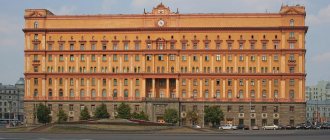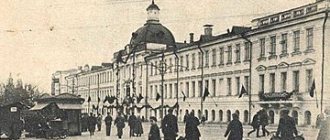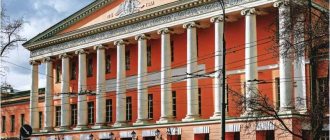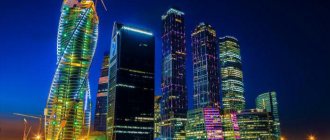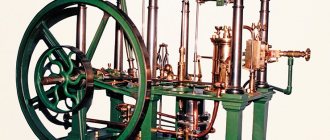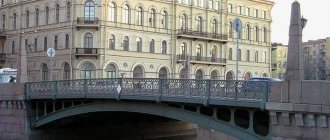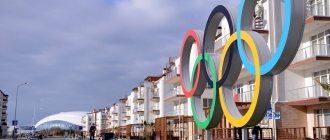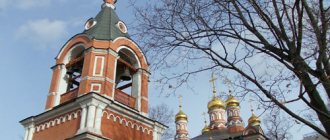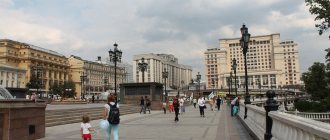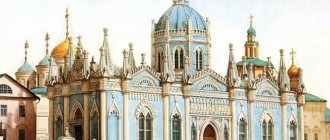The building of the House of Unions (Noble Assembly) is located at Bolshaya Dmitrovka Street, 1.
Nearest metro station: Teatralnaya.
Now the building is called the “House of Unions”. Used for concerts and events.
History of the building
In 1783, a noble social club was created. Such clubs eventually became common in large cities of Russia. The initiators of the creation of the clubs were the trustee of the Board of Trustees M.F. Soimonov and Prince A.B. Golitsyn. The noble meeting became a kind of alternative to the English Club (the domestic version, with more liberal rules of membership). Members of the Noble Assembly could be hereditary nobles (men and women). The Noble Assembly was headed by 12 elected elders (each year their composition was renewed by a third). The club was financed through annual contributions from members of the Noble Assembly.
In 1784, the Noble Assembly acquired the current building on Bolshaya Dmitrovka - the house of the former Moscow Governor-General V.M. Dolgorukova. The building was built in the first half of the 18th century and was rebuilt in 1784 - 1787 by M.F. Kazakov. The architect combined all the manor buildings into one building and built a Column Hall in its center, on the territory of the former inner manor courtyard. The house was heavily damaged in a fire in 1812 and was restored in 1814 by Kazakov’s student A.N. Bakarev.
Traditional balls (on Tuesdays) and evenings were held in the building of the Noble Assembly. In it, Moscow nobles received Russian emperors who came to the city. According to the charter of 1849, members of the Noble Assembly could invite “guests” (personal nobles, honorary citizens, merchants of the 1st guild, artists). At the head of the Noble Assembly was the elected Council of Elders, to which the economic committee and office were subordinate. The noble assembly had a rich library.
It is interesting that Catherine II ordered that the house purchased in the name of the elder of the Noble Assembly, Prince Golitsyn, be considered the private property of the Moscow nobility. Thus, a precedent was created when a public organization was recognized, in fact, as a legal entity.
It is known that M.Yu. Lermontov celebrated the New Year of 1832 at the Noble Assembly. He came to the festive masquerade dressed as an astrologer.
After the revolution of 1917, the Noble Assembly was liquidated, its building was transferred to trade unions and was named the House of Unions. Congresses of the Comintern and Profintern, other official events were held here, and concert activities continued. The building was often used for civil funeral services for high-ranking Soviet officials.
In the building of the House of Unions a farewell ceremony was held for the body of I.V. Stalin. The coffin with the leader’s body was installed on March 6, 1953 in the Column Hall of the House of Unions for farewell. At 16:00, access was open to everyone who wished to say goodbye to the leader. Unfortunately, there were so many people willing that a terrible stampede arose on Trubnaya Street, in which several thousand people died.
Important historical events took place in the building
On March 30, 1856, Emperor Alexander II made a speech about the need to liberate the peasants.
In the second half of the 19th century, P.I. performed concerts in the Hall of Columns. Tchaikovsky, N.A. Rimsky-Korsakov, S.V. Rachmaninov, F. Liszt and others.
In June 1880, on the days of the opening of the monument to A.S. in Moscow. Pushkin, F.M. Dostoevsky delivered a famous speech here dedicated to the memory of the poet.
Notes[ | ]
- Buseva-Davydova, 1997, p. 68-69.
- Column Hall of the House of Unions (undefined)
. TimeOut. Date accessed: April 6, 2021. - ↑ 1 2 3 4 5 6 Myasnikov A.
100 great sights of Moscow. - M.: Veche, 2014. - 320 p. — ISBN 978-5-4444-1978-6. - ↑ 12
Krupnova, 1981, p. 19. - Krupnova, 1981, p. 7.
- Bulgakov, 2008, p. 19.
- Krupnova, 1981, p. 8.
- Krupnova, 1981, p. 9-11.
- Bulgakov, 2008, p. 22.
- ↑ 12
Krupnova, 1981, p. 12. - ↑ 1 2
Architecture
(undefined)
. House of Unions. Date accessed: April 6, 2021. - Krupnova, 1981, p. 16-17.
- Domshlak, 1989, p. 145.
- Krupnova, 1981, p. 18-19.
- Krupnova, 1981, p. 20.
- Shokarev, 2011, p. 75.
- Krupnova, 1981, p. 29-30.
- Bulgakov, 2008, p. 48.
- Bulgakov, 2008, p. 51-52.
- Bulgakov, 2008, p. 82.
- Krupnova, 1981, p. 33.
- Bulgakov, 2008, p. 92.
- Krupnova, 1981, p. eleven.
- Krupnova, 1981, p. 34-35.
- Vostryshev, 2011, p. 32.
- ↑ 1 2 Malov Yu.
My Moscow streets. - M.: E.RA, 2014. - 220 p. — ISBN 978-5-000390-100-6. - Krupnova, 1981, p. 44-45.
- Romanyuk S.
Heart of Moscow. From the Kremlin to the White City. - M.: Tsentrpoligraf, 2013. - 912 p. — ISBN 978-5-227-04778-6. - Krupnova, 1981, p. 48.
- Bronovitskaya, 2015, p. 35.
- Bronovitskaya, 2015, p. 40.
- Bulgakov, 2008, p. 144-145.
- Pobochny V., Antonova L.
Spring-summer battles (04/21/07/16/1942). - St. Petersburg: Asterion, 2015. - 97 p. — ISBN 978-5-900995-07-6. - Adonyeva S. B. History of the modern New Year tradition // Mythology and everyday life. Vol. 2. Materials of the scientific conference: February 24-26, 1999. St. Petersburg, 1999
- Bulgakov, 2008, p. 131.
- Krupnova, 1981, p. 52.
- Bulgakov, 2008, p. 170.
- Krupnova, 1981, p. 55.
- Krupnova, 1981, p. 39.
- Lopukhin, 2014, p. 46.
- Drozdov D.
Kitay-Gorod, Lubyanka, Teatralnaya, Arbatskaya. Pedestrian walks in the vicinity of the metro. - M.: Tsentrpoligraf, 2021. - 256 p. — ISBN 978-5-227-07552-9. - Special operation “Funeral of Stalin” (unspecified)
. Komsomolskaya Pravda (March 7, 2013). Date accessed: April 6, 2018. - How Stalin was buried. The main Soviet funerals of the twentieth century (unspecified)
. Life (March 9, 2018). Date accessed: April 6, 2021. - Bulgakov, 2008, p. 175.
- Carriage racing. How the Soviet Union survived the “era of great funerals” (unspecified)
. Arguments and facts (November 11, 2014). Access date: October 22, 2018. - Kliment Voroshilov - the first Red Marshal (undefined)
. Source (April 23, 2016). Date accessed: October 22, 2021. - Putin said goodbye to Yevgeny Primakov (unspecified)
. Tass (29 June 2015). Date accessed: April 6, 2021. - Krupnova, 1981, p. 67-68.
- Krupnova, 1981, p. 72-73.
- Soviet time. House of Unions (undefined)
. House of Unions. Date accessed: April 6, 2021. - Globalization was started in the Hall of Columns (unspecified)
. Kommersant.ru (February 8, 2002). Date accessed: April 6, 2018. - “For loyalty to science”: present and future (undefined)
. Trinity option - science (February 24, 2015). Date accessed: April 6, 2021. - About the House of Unions. History (undefined)
. House of Unions. Date accessed: April 6, 2021. - Order of the President of the Russian Federation dated October 3, 2019 No. 336-rp
Building of the Noble Assembly (House of Unions)
The building of the Noble Assembly (House of Unions) is a real masterpiece of Moscow architecture, made in the style of mature classicism. The historical site is located in the center of the capital on the corner of Bolshaya Dmitrovka and Okhotny Ryad.
The mansion was built in the first half of the 18th century for Prince Vasily Mikhailovich Dolgoruky-Krymsky. The project was carried out by the outstanding Russian architect of that time, Matvey Fedorovich Kazakov.
In 1784, the building was purchased from the prince's heirs by the Moscow noble assembly for holding balls and receptions. The estate was not very suitable for these purposes, so Kazakov was ordered to redo the project.
From 1784 to 1790 A large-scale reconstruction of the estate was carried out. Buildings that stood separately from each other were combined into one. The architect decorated the main facade with a six-column Ionic portico, and emphasized the corners with small porticos with Doric pilasters. The first floor was equipped for household needs, and the second floor housed a library and formal living rooms. The courtyard was turned into the Great Hall. Subsequently, it became one of the main attractions of Moscow. The solemn appearance of the hall was determined by the magnificent colonnade. Along the perimeter there were 28 white columns of the Corinthian order, lined with artificial marble. The columns gave the room an impression of harmony and lightness, despite the fact that they were quite massive. The impression was further enhanced by the use of mirrors that were installed instead of windows. Huge crystal chandeliers hung between the columns. The walls were covered with paintings by Antonio Canoppi. The ceiling was covered with canvas and painted by the artist Giovanni Batista Scoti. Unfortunately, all the drawings were lost in a fire in 1812.
The former princely estate very quickly turned into the center of cultural and social life of the Moscow elite. Many famous personalities (Lermontov, Pushkin, Baratynsky) came to the balls organized in the Great Hall. Also, influential people from Europe liked to attend these events.
The hall was famous for its excellent acoustics, so after some time concerts began to be held here. Even European celebrities sought to perform in this place.
After the fire of 1812, the building of the Noble Assembly was badly damaged. It was restored by the architect Alexei Nikitich Bakarev (a student of Matvey Kazakov). Funds for repairs were partially allocated by Emperor Alexander I.
The next large-scale reconstruction of the building was carried out at the beginning of the 19th century with the participation of Moscow architect Alexander Meisner. He changed the layout of some rooms, the appearance of the facades and added a third floor. The building has acquired a more modern and familiar look to us. Only the Great Hall remained untouched.
After the revolution, the Noble Assembly was liquidated. The Council of People's Commissars handed over the house to the trade unions. Since then, it has received the appropriate name - the House of Unions. The Great Hall was also renamed. It began to be called Column. In 1918, the first concert for workers took place here. It was attended by N.K. Krupskaya and V.I. Lenin.
Later, school graduations, chess competitions, New Year trees for children, and public conventions were held here.
In 1967, another restoration of the building was carried out, since many of the wooden floors and structures had already collapsed. During the work, the colonnade was restored, the foundation was strengthened, and the interior was restored.
After the collapse of the Soviet Union, the Noble Assembly Building became a closed joint stock company. It began renting out halls. It often hosted presentations of various thematic areas, forums, and congresses. Musical concerts by world-class performers were held in the Hall of Columns. The interior has been preserved from the times of noble balls and is still very beautiful.
Interesting Facts
- The House of Unions is a cultural heritage site of federal significance.
- The excellent acoustics in the Hall of Columns is due to the presence of a flat wooden ceiling, which acts as a soundboard. It reflects and enhances sound well.
- Sergei Rachmaninov, Pyotr Tchaikovsky, Galina Barinova, Fyodor Chaliapin, Valentina Tolkunova, Leonid Utesov, Klavdiya Shulzhenko and many other famous personalities gave concerts in the Hall of Columns.
Sanctuaries of Queen Mut and the god Khonsu
The part of the cult complex dedicated to Queen Mut is located southwest of the Temple of Amun-Ra and is connected to it by an enfilade of various courtyards and pylons. From the outermost, southern gate of the temple complex of the god Amun to the sanctuary of Mut there is a 350-meter alley with 66 ram-headed sphinxes.
The area of the sanctuary of Queen Mut is almost 4 times smaller than the area of the ensemble dedicated to the god Amun-Ra. The central structure here is the temple of the goddess Mut, built under Seti I. This building is surrounded on three sides by a natural reservoir that has existed since ancient times.
Next to the central building is the “maternity hospital” of Ramesses III and the temple of the god Kamutef.
On the southwestern side of the cult ensemble in Karnak stands the temple of Khonsu, dedicated to the moon god Khonsu - that was the name of the son of the gods Amun and Mut. This building is quite dark inside and has a rough finish.
Find out prices or book a car online in one of 160 countries
brief information
The organization JSC "HOUSE OF UNIONS" was registered on 08/09/1993 by the registrar: Interdistrict Inspectorate of the Federal Tax Service No. 46 for Moscow
.
After registration, the company was assigned: OGRN: 1037739226403, INN: 7710042590 and KPP: 771001001. The main type of activity is “ Activities of cultural and art institutions
”, the organization also has 21 additional types of activities. Legal address of JSC "HOUSE OF UNIONS" - 125009, Moscow, st. Dmitrovka B., 1.
Address on the map
Modernity[ | ]
After the collapse of the USSR, the House of Unions became a closed joint-stock company[50]. As of 2021, it rents out halls for various events, conventions and conferences. In 2002, the forum “Globalization of the economy, regional integration, the impact of these processes on the situation of workers”[51] was held in the Hall of Columns, and in February 2015, the award ceremony for the prize “For Fidelity to Science”[52]. Music concerts are also held in the Hall of Columns. Lyudmila Zykina, Klavdia Shulzhenko, Leonid Utesov, Joseph Kobzon, Lev Leshchenko, Valentina Tolkunova, Eduard Khil, Lyudmila Senchina, Sofia Rotaru, Edita Piekha, Muslim Magomaev, Arkady Raikin, Gennady Khazanov, Victor Chistyakov and many others performed on its stage[53 ].
On October 3, 2021, Russian President Vladimir Putin signed a decree on the temporary location of the State Duma in the House of Unions[54].
